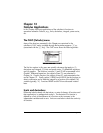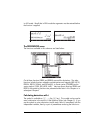
Page 13-6
To evaluate the derivative in the Equation Writer, press the up-arrow key —,
four times, to select the entire expression, then, press @EVAL. The derivative will
be evaluated in the Equation Writer as:
The chain rule
The chain rule for derivatives applies to derivatives of composite functions. A
general expression for the chain-rule is d{f[g(x)]}/dx = (df/dg)⋅ (dg/dx). Using
the calculator, this formula results in:
The terms d1 in front of g(x) and f(g(x)) in the expression above are
abbreviations the calculator uses to indicate a first derivative when the
independent variable, in this case x, is clearly defined. Thus, the latter result is
interpreted as in the formula for the chain rule shown above. Here is another
example of a chain rule application:
Note: The symbol ∂ is used formally in mathematics to indicate a partial
derivative, i.e., the derivative of a function with more than one variable.
However, the calculator does not distinguish between ordinary and partial
derivatives, utilizing the same symbol for both. The user must keep this
distinction in mind when translating results from the calculator to paper.


















